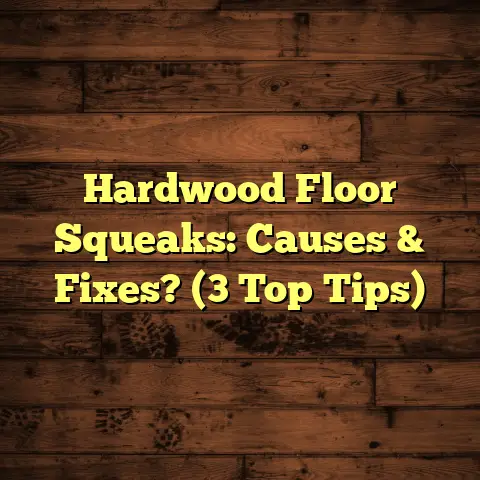Prep Wood Floors For Stain? (7 Sanding Secrets!)
Have you ever dreamed of transforming your dull, lifeless wood floors into a stunning showcase of beauty and elegance with just a few simple steps?
I know I have! For years, I’ve been helping homeowners just like you achieve that perfect, rich, and even stain on their wood floors.
And let me tell you, it all boils down to the prep work. It’s not just about slapping on some stain and hoping for the best.
It’s about understanding the wood, the stain, and the process.
Let’s dive into the secrets that will take your wood floors from drab to fab!
1. Understanding the Importance of Preparation
Why is preparation so crucial? Well, think of it like this: your wood floor is the canvas, and the stain is the paint.
If the canvas is rough, uneven, or dirty, your paint job will suffer.
The same goes for wood floors.
Inadequate preparation can lead to a whole host of problems, including:
- Uneven Staining: Some areas absorb more stain than others, resulting in a blotchy, inconsistent look.
- Blotchiness: This is especially common with softwoods like pine, where the grain absorbs stain unevenly.
- Poor Adhesion: The stain may not properly adhere to the wood, leading to peeling or flaking later on.
- Visible Scratches: Sanding imperfections become glaringly obvious once the stain is applied.
Trust me, I’ve seen it all. I’ve been called in to fix projects where homeowners skipped the prep work, and the results were… less than ideal.
So, take it from me: preparation is key!
2. Secret #1: Choosing the Right Sandpaper
Sandpaper is your best friend in this process. But not all sandpaper is created equal.
You’ll need a variety of grits to achieve a smooth, stain-ready surface.
Here’s a breakdown of the common grits and their uses:
| Grit Range | Use |
|---|---|
| 36-40 | Removing old finishes, leveling uneven floors |
| 60-80 | Initial sanding to remove scratches and imperfections |
| 100-120 | Smoothing the surface, preparing for finer grits |
| 150-180 | Final sanding for a smooth, stain-ready surface |
Source: National Wood Flooring Association (NWFA) Guidelines
Why is grit selection so important?
Using too coarse a grit can leave deep scratches that are difficult to remove.
Using too fine a grit too early can clog the sandpaper and waste your time.
My Recommendation:
Start with a grit appropriate for the condition of your floors.
If you’re removing an old finish, begin with 36-40 grit.
If your floors are already in decent shape, you can start with 60-80 grit.
Then, gradually work your way up through the grits, ending with 150-180 grit.
Bonus Tip:
Invest in high-quality sandpaper.
Cheap sandpaper dulls quickly and can leave behind residue.
I personally prefer using ceramic or aluminum oxide sandpaper for its durability and effectiveness.
3. Secret #2: The Right Sanding Technique
Okay, so you’ve got your sandpaper. Now, let’s talk technique.
There are several different sanding techniques, and choosing the right one is crucial for achieving a professional-looking finish.
- Drum Sanding: This is the most aggressive sanding method, typically used for large areas and removing significant imperfections. Requires expertise to avoid damaging the floor.
- Edge Sanding: Used to sand along the edges of the room, where the drum sander can’t reach. Essential for blending the edges with the rest of the floor.
- Random Orbital Sanding: A less aggressive method that’s great for smoothing the surface and removing swirl marks left by the drum sander. More forgiving than drum sanding, making it ideal for DIYers.
Maintaining Even Pressure and Direction:
One of the biggest mistakes I see homeowners make is applying too much pressure or sanding in the wrong direction.
Always sand with the grain of the wood.
This will help to avoid cross-grain scratches that will be very visible after staining.
Apply even pressure and overlap each pass by about 50%.
This will ensure that you’re sanding the entire surface evenly.
Dealing with Swirl Marks:
Swirl marks are the enemy!
They’re caused by the circular motion of the sander and can be difficult to remove.
To minimize swirl marks, use a random orbital sander and move it slowly and steadily across the floor.
Overlap each pass and avoid stopping the sander while it’s in contact with the wood.
4. Secret #3: The Importance of Dust Removal
Dust is the bane of any wood finishing project.
It can contaminate your stain, create a rough surface, and generally make your life miserable.
That’s why thorough dust removal is absolutely essential after sanding and before staining.
Effective Methods for Dust Removal:
- Vacuuming: Use a shop vacuum with a brush attachment to remove the bulk of the dust. Pay close attention to corners, edges, and crevices.
- Tack Cloths: These are sticky cloths that pick up any remaining dust particles. Wipe the floor with a tack cloth after vacuuming.
- Damp Mopping: Use a slightly damp mop (not soaking wet!) to remove any lingering dust. Be sure to use a clean mop and change the water frequently.
Why is dust removal so important?
Dust particles can interfere with the stain’s ability to penetrate the wood, leading to uneven color and poor adhesion.
They can also create a rough, gritty surface that detracts from the beauty of your finished floors.
My Pro Tip:
After vacuuming and tacking, let the floor sit for a few hours to allow any remaining dust to settle.
Then, do one final pass with the tack cloth before staining.
5. Secret #4: Staining Test Patches
Before you commit to staining your entire floor, it’s crucial to test the stain on a small, inconspicuous area.
This will allow you to see how the stain looks on your particular wood species and how it absorbs the color.
Why Test Patches are Essential:
- Different Wood Species, Different Results: Different wood species absorb stain differently. For example, pine tends to be blotchy, while maple can be difficult to stain at all.
- Color Variation: The color of the stain can vary depending on the wood’s natural color and the number of coats applied.
- Preventing Disasters: Testing the stain beforehand can prevent you from making a costly mistake on your entire floor.
How to Create Test Patches:
- Sand a small area of your floor (e.g., in a closet or under a piece of furniture) using the same sanding process you’ll use on the rest of the floor.
- Apply the stain to the test area, following the manufacturer’s instructions.
- Let the stain sit for the recommended amount of time, then wipe off the excess.
- Allow the stain to dry completely.
- Evaluate the color and appearance of the stained area.
My Experience:
I once worked on a project where the homeowner insisted on skipping the test patches.
She chose a dark walnut stain for her oak floors, and the result was a muddy, almost black color.
We had to completely re-sand the floors and start over.
Learn from her mistake: always test your stain!
6. Secret #5: Conditioning the Wood
Wood conditioners are a game-changer, especially for softwoods like pine.
They help to even out the wood’s porosity, preventing blotchiness and ensuring a more uniform stain.
How Wood Conditioners Work:
Wood conditioners are typically clear liquids that penetrate the wood and partially seal the pores.
This reduces the amount of stain that the wood can absorb, resulting in a more even color.
When to Use a Wood Conditioner:
- Softwoods: Pine, fir, and other softwoods are prone to blotchiness and should always be conditioned before staining.
- Uneven Grain: If your wood has areas of dense grain and areas of open grain, a conditioner can help to even out the absorption rate.
- Light Colors: Light-colored stains tend to highlight imperfections, so a conditioner can help to create a smoother, more uniform finish.
How to Apply a Wood Conditioner:
- Apply the conditioner liberally to the wood surface using a brush or rag.
- Allow the conditioner to soak in for the recommended amount of time (usually 5-15 minutes).
- Wipe off any excess conditioner with a clean rag.
- Allow the conditioner to dry completely before staining.
Important Note:
Always follow the manufacturer’s instructions for the specific wood conditioner you’re using.
Some conditioners may require a longer drying time or special application techniques.
7. Secret #6: Timing is Everything
Environmental factors like humidity and temperature can significantly impact the staining process.
Staining wood floors in the wrong conditions can lead to problems like slow drying, uneven color, and poor adhesion.
Ideal Conditions for Staining:
- Temperature: The ideal temperature for staining is between 60°F and 80°F (15°C and 27°C).
- Humidity: The ideal humidity level is between 40% and 60%.
Why are these conditions important?
- Temperature: High temperatures can cause the stain to dry too quickly, leading to uneven color. Low temperatures can slow down the drying process and increase the risk of the stain running or dripping.
- Humidity: High humidity can prevent the stain from drying properly, leading to a sticky, tacky finish. Low humidity can cause the wood to dry out too quickly, leading to cracking or warping.
How to Control Environmental Factors:
- Temperature: Use a heater or air conditioner to maintain the ideal temperature in the room.
- Humidity: Use a humidifier or dehumidifier to maintain the ideal humidity level.
- Ventilation: Ensure adequate ventilation in the room to help the stain dry properly.
My Personal Experience:
I once tried to stain a floor on a particularly humid day, and the stain took forever to dry.
It remained tacky for days, and the finish was uneven and blotchy.
I learned my lesson: always check the weather forecast before staining!
8. Secret #7: Proper Application Techniques
The way you apply the stain can have a big impact on the final result.
There are several different methods of applying stain, each with its own pros and cons.
- Brush: Brushes are great for applying stain to small areas and intricate details. They allow for precise control and can create a smooth, even finish.
- Rag: Rags are ideal for applying stain to large areas quickly and efficiently. They’re also good for creating a textured or distressed look.
- Sponge: Sponges are a good option for applying stain to uneven surfaces or hard-to-reach areas. They can also be used to create a unique, mottled effect.
Tips for Achieving a Smooth, Even Application:
- Use a High-Quality Applicator: Invest in a good-quality brush, rag, or sponge that won’t shed fibers or leave behind streaks.
- Apply the Stain in Thin Coats: Avoid applying the stain too thickly, as this can lead to uneven color and slow drying.
- Work in Small Sections: Apply the stain to a small section of the floor at a time, then wipe off the excess before moving on to the next section.
- Overlap Each Pass: Overlap each pass by about 50% to ensure that the entire surface is covered evenly.
- Wipe Off the Excess: After applying the stain, wipe off any excess with a clean rag. This will help to prevent blotchiness and ensure a smooth, even finish.
My Go-To Method:
I personally prefer using a rag for most staining projects.
I find that it gives me the best control and allows me to achieve a smooth, even finish quickly and efficiently.
However, I’ll often use a brush for edging and detail work.
Conclusion
Prepping wood floors for stain is an art, and like any art, it requires knowledge, skill, and a little bit of patience.
But trust me, the results are worth it!
By following these seven sanding secrets, you can transform your dull, lifeless wood floors into a stunning showcase of beauty and elegance.
Remember:
- Preparation is key!
- Choose the right sandpaper.
- Use the right sanding technique.
- Remove dust thoroughly.
- Test your stain.
- Condition the wood.
- Time your project carefully.
- Apply the stain properly.
So, go ahead and embrace these techniques.
Your dream wood floor finish is within reach!
With the right preparation and knowledge, your wood floors can become the stunning focal point of your home.
Now, go out there and create some beautiful floors!





